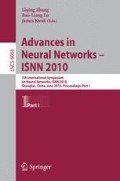Abstract
This paper studies the extension of the Generalization Complexity (GC) measure to real valued input problems. The GC measure, defined in Boolean space, was proposed as a simple tool to estimate the generalization ability that can be obtained when a data set is learnt by a neural network. Using two different discretization methods, the real valued inputs are transformed into binary values, from which the generalization complexity can be straightforwardly computed. The discretization transformation is carried out both through a very simple method based on equal width intervals (EW) and with a more sophisticated supervised method (the CAIM algorithm) that use much more information about the data. A study of the relationship between data complexity and generalization ability obtained was done together with an analysis of the relationship between best neural architecture size and complexity.
Access this chapter
Tax calculation will be finalised at checkout
Purchases are for personal use only
Preview
Unable to display preview. Download preview PDF.
References
Baum, E.B., Haussler, D.: What Size Net Gives Valid Generalization? Neural Comput. 1(1), 151–160 (1990)
Prechelt, L.: A Set of Neural Network Benchmark Problems and Benchmarking Rules. Technical Report 21/94. Fakultat fur Informatik, U. Kalrsruhe, Germany (1994)
Barron, A.R.: Approximation and Estimation Bounds for Artificial Neural Networks. Mach. Learn. 14(1), 115–133 (1994)
Camargo, L.S., Yoneyama, T.: Specification of Training Sets and the Number of Hidden Neurons for Multilayer Perceptrons. Neural Comput. 13(12), 2673–2680 (2001)
Teoh, E., Xiang, C., Chen, K.: Estimating the Number of Hidden Neurons in a Feedforward Network Using the Singular Value Descomposition. In: Wang, J., Yi, Z., Żurada, J.M., Lu, B.-L., Yin, H. (eds.) ISNN 2006. LNCS, vol. 3971, pp. 858–865. Springer, Heidelberg (2006)
Mirchandani, G., Cao, W.: On Hidden Nodes for Neural Nets. IEEE Trans. on Circuits and Systems 36(5), 661–664 (1989)
Arai, M.: Bounds on the Number of Hidden Units in Binary-Valued Three-Layer Neural Networks. Neural Networks 6(6), 855–860 (1993)
Zhang, Z., Ma, X., Yang, Y.: Bounds on the Number of Hidden Neurons in Three-Layer Binary Neural Networks. Neural Networks 16(7), 995–1002 (2003)
Yuan, H.C., Xiong, F.L., Huai, X.Y.: A Method for Estimating the Number of Hidden Neurons in Feedforward Neural Networks Based on Information Entropy. In: Computers and Electronics in Agriculture, pp. 57–64 (2003)
Liu, Y., Janusz, A., Zhu, Z.: Optimizing the Number of Hidden Neurons in Neural Networks. In: AIAP 2007, Proceedings of the 25th IASTED International Multi-Conference, pp. 121–126 (2007)
Haykin, S.: Neural Networks: A Comprehensive Foundation. Macmillan, New York (1994)
Gómez, I., Franco, L., Jerez, J.: Neural Network Architecture Selecion. Can Function Complexity Help? Neural Processing Letters 30, 71–87 (2009)
Franco, L., Anthony, M.: The Influence of Oppositely Classified Examples on the Generalization Complexity of Boolean Functions. IEEE Transactions on Neural Networks 17, 578–590 (2006)
Franco, L.: Generalization Ability of Boolean Functions Implemented in FeedForward Neural Networks. Neurocomputing 70, 351–361 (2006)
Franco, L., Cannas, S.A.: Generalization and Selection of Examples in Feedforward Neural Networks. N. Comp. 12(10), 2405–2426 (2000)
Franco, L., Cannas, S.A.: Generalization Properties of Modular Networks: Implementing the Parity Function. IEEE Trans. on Neural Networks 12, 1306–1313 (2001)
Masters, T.: Practical Neural Network Recipes in C++. Academic Press Professional, Inc., London (1993)
Neuralware, Inc.: The Reference Guide (2001)
Witten, I., Frank, E.: Data Mining: Practical Machine Learning Tools and Techniques. Morgan Kaufmann, San Francisco (2005)
Wong, A.K., Chiu, D.K.: Synthesizing Statistical Knowledge from Incomplete Mixed Mode Data. IEEE Trans. Pattern Analysis and Machine Intelligence 9, 796–805 (1987)
Paterson, A., Nibblet, T.B.: ACLS Manual. Int. Teminals Ltd., Edinburgh (1987)
Fayyad, U.M., Irani, K.B.: Multi-Interval Discretization of Continuous Valued Attributes for Clasification Learning. In: Proceedings of the 13th International Joint Conference Artificial Intelligence, pp. 1022–1027 (1993)
Dougherty, J., Hohavi, R., Sahami, R.: Supervised and Unsupervised Discretization of Continuous Features. In: Proceedings 12th International Conference Machine Learning, pp. 194–202 (1995)
Kerber, R.: Chimerge. Discretization of Numeric Attributes. In: Proceedings of Ninth International Conference of Artificial Intelligence, pp. 123–128 (1992)
Liu, H., Setiono, R.: Feature Selection Via Discretization. IEEE Knowledge and Data Eng. 9(4), 642–645 (1997)
Moller, M.F.: Scaled Conjugate Gradient Algorithm for Fast Supervised Learning. Neural Networks 6(4), 525–533 (1993)
Kurgan, L.A., Cios, K.J.: CAIM Discretization Algorithm. IEEE Transactions of Knoweledge and Data Eng. 16(2), 145–153 (2004)
Maimon, O., Rokach, L.: Data Mining and Knoweledge Discovery Handbook. Springer, New York (2005)
Author information
Authors and Affiliations
Editor information
Editors and Affiliations
Rights and permissions
Copyright information
© 2010 Springer-Verlag Berlin Heidelberg
About this paper
Cite this paper
Gómez, I., Franco, L., Jerez, J.M., Subirats, J.L. (2010). Extension of the Generalization Complexity Measure to Real Valued Input Data Sets. In: Zhang, L., Lu, BL., Kwok, J. (eds) Advances in Neural Networks - ISNN 2010. ISNN 2010. Lecture Notes in Computer Science, vol 6063. Springer, Berlin, Heidelberg. https://doi.org/10.1007/978-3-642-13278-0_12
Download citation
DOI: https://doi.org/10.1007/978-3-642-13278-0_12
Publisher Name: Springer, Berlin, Heidelberg
Print ISBN: 978-3-642-13277-3
Online ISBN: 978-3-642-13278-0
eBook Packages: Computer ScienceComputer Science (R0)

